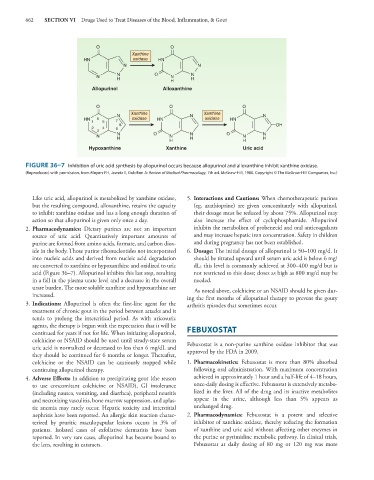Page 676 - Basic _ Clinical Pharmacology ( PDFDrive )
P. 676
662 SECTION VI Drugs Used to Treat Diseases of the Blood, Inflammation, & Gout
O O
Xanthine
HN oxidase HN
N N
N O N
N N
H H H
Allopurinol Alloxanthine
O O O
Xanthine Xanthine
N N N
HN 6 oxidase HN oxidase HN
1 5 7
8 OH
2 4 9
3
N N O N N O N N
H H H H H
Hypoxanthine Xanthine Uric acid
FIGURE 36–7 Inhibition of uric acid synthesis by allopurinol occurs because allopurinol and alloxanthine inhibit xanthine oxidase.
(Reproduced, with permission, from Meyers FH, Jawetz E, Goldfien A: Review of Medical Pharmacology, 7th ed. McGraw-Hill, 1980. Copyright © The McGraw-Hill Companies, Inc.)
Like uric acid, allopurinol is metabolized by xanthine oxidase, 5. Interactions and Cautions: When chemotherapeutic purines
but the resulting compound, alloxanthine, retains the capacity (eg, azathioprine) are given concomitantly with allopurinol,
to inhibit xanthine oxidase and has a long enough duration of their dosage must be reduced by about 75%. Allopurinol may
action so that allopurinol is given only once a day. also increase the effect of cyclophosphamide. Allopurinol
2. Pharmacodynamics: Dietary purines are not an important inhibits the metabolism of probenecid and oral anticoagulants
source of uric acid. Quantitatively important amounts of and may increase hepatic iron concentration. Safety in children
purine are formed from amino acids, formate, and carbon diox- and during pregnancy has not been established.
ide in the body. Those purine ribonucleotides not incorporated 6. Dosage: The initial dosage of allopurinol is 50–100 mg/d. It
into nucleic acids and derived from nucleic acid degradation should be titrated upward until serum uric acid is below 6 mg/
are converted to xanthine or hypoxanthine and oxidized to uric dL; this level is commonly achieved at 300–400 mg/d but is
acid (Figure 36–7). Allopurinol inhibits this last step, resulting not restricted to this dose; doses as high as 800 mg/d may be
in a fall in the plasma urate level and a decrease in the overall needed.
urate burden. The more soluble xanthine and hypoxanthine are As noted above, colchicine or an NSAID should be given dur-
increased. ing the first months of allopurinol therapy to prevent the gouty
3. Indications: Allopurinol is often the first-line agent for the arthritis episodes that sometimes occur.
treatment of chronic gout in the period between attacks and it
tends to prolong the intercritical period. As with uricosuric
agents, the therapy is begun with the expectation that it will be FEBUXOSTAT
continued for years if not for life. When initiating allopurinol,
colchicine or NSAID should be used until steady-state serum
uric acid is normalized or decreased to less than 6 mg/dL and Febuxostat is a non-purine xanthine oxidase inhibitor that was
they should be continued for 6 months or longer. Thereafter, approved by the FDA in 2009.
colchicine or the NSAID can be cautiously stopped while 1. Pharmacokinetics: Febuxostat is more than 80% absorbed
continuing allopurinol therapy. following oral administration. With maximum concentration
4. Adverse Effects: In addition to precipitating gout (the reason achieved in approximately 1 hour and a half-life of 4–18 hours,
to use concomitant colchicine or NSAID), GI intolerance once-daily dosing is effective. Febuxostat is extensively metabo-
(including nausea, vomiting, and diarrhea), peripheral neuritis lized in the liver. All of the drug and its inactive metabolites
and necrotizing vasculitis, bone marrow suppression, and aplas- appear in the urine, although less than 5% appears as
tic anemia may rarely occur. Hepatic toxicity and interstitial unchanged drug.
nephritis have been reported. An allergic skin reaction charac- 2. Pharmacodynamics: Febuxostat is a potent and selective
terized by pruritic maculopapular lesions occurs in 3% of inhibitor of xanthine oxidase, thereby reducing the formation
patients. Isolated cases of exfoliative dermatitis have been of xanthine and uric acid without affecting other enzymes in
reported. In very rare cases, allopurinol has become bound to the purine or pyrimidine metabolic pathway. In clinical trials,
the lens, resulting in cataracts. Febuxostat at daily dosing of 80 mg or 120 mg was more

